Plant Profiles
Click on the first letter of the common name of the plant you wish more information about.
A | B | C | D | E | F | G | H | I | J | K | L | M | N | O | P | Q | R | S | T | U | V | W | X | Y | Z
H
- Hardy Bamboo Palm
- Heavenly Bamboo
- Hindu Rope Plant
- Holiday Cactus
- Hollyhock
- Horsemint
- Hybrid Tea Rose
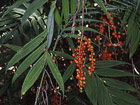
Hardy Bamboo Palm
Scientific Name: Chamaedorea microspadix
Growth Habit: An upright, clump-forming palm with numerous shoots from the ground that grow to 8 feet tall. The leaves grow up to a yard long and a foot wide, being formed by up to 20 medium-green leaflets.
Light: Needs filtered-sun to shady sites.
Feedings: Apply a slow-release palm fertilizer once monthly in March, June and September.
Water Needs: Prefers moist soils but survives short periods of drought. Grows best with weekly waterings.
Ease of Culture: Easy.
Propagation: Start plants from seed.
Hardiness: Hardy.
Major Problems: May be affected by scale insects and mites that can be controlled with a natural oil spray as needed.
Pruning: Remove declining fronds and old fruit clusters as needed. Also remove shoots that may be growing out of bounds or invading nearby plantings.
Uses: A great selection for the shady sites, especially where a tropical look is desired. Plantings can serve as a view barrier and backdrop for other shade-loving garden selections. The mature trunks sprout pendulous clusters of white flowers from the base of the leaves during the warmer months. The flowers give way to bright orange-and-red fruits. Palm clusters also can be grown in containers to set on a shaded patio or balcony.
Florida Native: No; native to eastern Mexico.
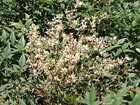
Heavenly Bamboo
Scientific Name: Nandina domestica
Growth Habit: An upright evergreen shrub, with bamboolike stems and foliage that grows 6 to 8 feet tall. The leaves are dark green and compound, growing to 18 inches long and a foot wide consisting of numerous leaflets.
Light: Plant in full sun to lightly shaded locations.
Feedings: Apply a general garden fertilizer once monthly in March, June and September if needed for growth. Established plantings usually can exist with nutrients from decomposing mulches and nearby feedings of other plants.
Water Needs: Tolerates short periods of drought; grows best with waterings every 10 to 14 days.
Ease of Culture: Easy.
Propagation: Start plants from seed or by division of older clusters.
Hardiness: Hardy.
Major Problems: Scale insects might affect the stems and foliage. Apply a natural-oil spray if needed. Grow in well-drained soil to prevent root problems. In some areas, seed-producing types have become invasive.
Pruning: Each spring, remove some of older, declining shoots to make room for new growth. Remove suckers from the bases of older plants as needed to prevent invasion of nearby plantings.
Uses: Legend says planting a heavenly bamboo near your home brings good luck. Other uses include plantings as an attractive ground cover near foundations, displays along walkways and masses in difficult-to-maintain areas. Plants open clusters of white terminal blooms during April and May that give rise to oval fruits that turn a red color for November through January displays. The fruits are toxic if eaten. There are many new varieties with colorful foliage, white fruit, dwarf growth habits and minimal fruiting.
Florida Native: No; native to China, India and Japan.

Hindu Rope Plant
Scientific Name: Hoya carnosa
Growth Habit: A vining foliage plant with shoots growing to more than 4 feet long. The oval leaves are bright green, waxy and flat to curled, depending on the variety, and grow to 3 inches long and 1 inch wide.
Light: Plant in high-light locations, but avoid late-morning-through-afternoon sun.
Feedings: Apply a 20-20-20 or similar fertilizer solution mixed at the label rate monthly during periods of active growth. Slow-release fertilizers may be added to the container as a substitute for frequent feedings.
Water Needs: Thoroughly moisten the soil when the surface begins to dry.
Ease of Culture: Easy.
Propagation: Start plants from cuttings.
Hardiness: Tender; protect from temperatures below 45 degrees.
Major Problems: Mealybugs often feed along the stems and in the folds of leaves. Aphids can also be found at the tips of new shoots. Control both with soap or oil sprays following label instructions. Avoid overwatering to prevent root and crown-rot problems.
Pruning: Encourage branching by trimming the tips of shoots as needed to produce numerous stems of cascading foliage. Also give older plants a pruning to restrict growth and keep the shoots in bounds. Use the trimmings for cuttings.
Uses: An excellent plant for hanging baskets and tall planters to display on shaded porches and patios. May be hung from overhead rafters and tree limbs to keep the cascading foliage and flowers at eye level. Hoya can also be displayed in small containers to decorate tables and desks indoors. Older plants usually flower if kept in high-light locations. They open clusters of waxy pink starlike blooms forming a rounded inflorescence that often emits a pleasing fragrance.
Florida Native: No; native to Australia and China.
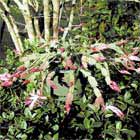
Holiday Cactus
Scientific Name: Schlumbergera hybrids
Growth Habit: A tropical cactus with bright green flattened arching branches and leaves. Edges may be rounded to coarsely toothed. Grows to 18 inches tall and often twice as wide.
Light: Grow outdoors in partial shade; indoors, select a high light area with no direct sun.
Feedings: Apply a liquid houseplant fertilizer every other week March through August.
Water Needs: Keep moist March through September; allow the surface soil to dry during the remaining cooler months.
Ease of Culture: Easy.
Propagation: Start new plants from leaf cuttings March through June to have plants in bloom for the holidays.
Hardiness: Tender; protect from temperatures below 45 degrees.
Major Problems: Plants are susceptible to a root rot fungus during the cooler months. Keeping plants on the dry side can prevent the decline.
Pruning: Create plants with strong arching and well-branched stems by pruning the tips during March. Remove one or two leaf segments from each branch to produce new plants.
Uses: A popular holiday and foliage plant for the home and landscape. Keep in a bright room, add to shaded patios or hang under trees during the warmer months.
Florida Native: No; native to Brazil but many hybrids have been developed locally.
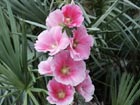
Hollyhock
Scientific Name: Alcea rosea
Growth Habit: An upright evergreen biennial, which, when flowering, grows to 6 feet tall and 2 feet wide. The leaves are bright green and rounded with 3 or more lobes and grow to 6 inches long and wide.
Light: Plant in full-sun locations.
Feedings: Apply a general garden fertilizer once a month during periods of growth.
Water Needs: Prefers a moist soil; water weekly, especially during periods of growth and when flowering.
Ease of Culture: Medium; timing of plantings is critical to have plants in bloom for spring.
Propagation: Start plants from seed during October or November.
Hardiness: Hardy.
Major Problems: Caterpillars, grasshoppers, slugs and snails may feed on the foliage, but controls seldom are needed.
Pruning: Remove declining plants at the end of the growing season after seeds have been saved for fall planting.
Uses: An old favorite for flower gardens reminiscent of northern landscapes that blooms April through June. The pink, red, yellow and white blossoms open to 4 inches in diameter along tall spikes. Cluster several plants for the best displays of color. Gardeners obtain the best results from local varieties, often shared between neighbors, to grow from seed during fall. These young plants must be added to the garden by late December to experience the cooler winter weather that helps initiate flowering during the spring season. Blooming plants also can be found at garden centers during late spring.
Florida Native: No; native to Europe and Asia.
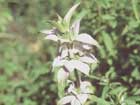
Horsemint
Scientific Name: Monarda punctata
Growth Habit: An upright evergreen with slightly arching branches growing to 4 feet tall and almost as wide. The leaves are bright green and lancelike, with toothed edges, growing to 3 inches long and 1/2 inch wide.
Light: Plant in full sun to lightly shaded locations.
Feedings: Apply a general garden fertilizer once monthly in March, June and September.
Water Needs: Tolerates short periods of drought, but grows best with weekly waterings.
Ease of Culture: Easy.
Propagation: Start plants from seed or cuttings and by dividing older clumps.
Hardiness: Hardy.
Major Problems: Plant in a well-drained soil to avoid root rot problems. Chewing insects may cause leaf damage but seldom need control.
Pruning: After months of growth, the plants grow tall and top heavy. Prune after flowering to encourage new growth and reshape the plants. Also prune during late winter to remove declining stems and restart spring growth.
Uses: An attractive clump-forming selection for the perennial and butterfly garden. Use as the featured accent plant May through October when it is in bloom or as a backdrop for contrasting annuals and perennials. The flower clusters develop at the top of the tall stems and are formed from pink to lavender bracts enclosing spotted yellow blossoms.
Florida Native: Yes.
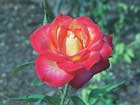
Hybrid Tea Rose
Scientific Name: Rosa hybrids
Growth Habit: Evergreen shrubs with an upright to slightly rounded shape growing to 6 feet tall and almost as wide; produces prickly stems with compound leaves having three, five or seven segments.
Light: Plant in full sun.
Feedings: Fertilize monthly with a general garden fertilizer or a product labeled for roses.
Water Needs: Prefers a moist soil; water every three to four days during the hot, dry seasons.
Ease of Culture: Medium; roses need regular care.
Propagation: By budding or from cuttings.
Hardiness: Hardy; severe freezes may damage leaves and stems.
Major Problems: Most rose selections are affected by black spot, a disease, and mites which can cause defoliation that weakens the plants. Sprays are usually needed. Other problems that may need control: thrips, caterpillars and powdery mildew.
Pruning: In mid-February, plants are reduced in size by one-third to one-half to control plant size and renew growth. Grooming to remove old flowers, lanky shoots and diseased or dead portions is performed year-round.
Uses: Hybrid tea roses often are planted in beds of assorted varieties. Flower colors include all but blue and may be a single color or a blend such as variety Perfect Moment (above). Single specimens also can be grown as accents with perennials or in containers to display on a sunny balcony or patio.
Florida Native: No; all are hybrids with mixed parentage.

